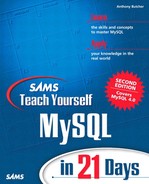Workshop
The quiz and exercises are provided to help you solidify your understanding of the material covered today. Try to understand the quiz and exercise answers before continuing to tomorrow's lesson.
Quiz
| 1: | True or False: A table lock, when obtained by one client, prevents other clients from reading from or writing to a table. |
| A1: | True for a write lock. With a read lock, the statement is not true because it allows other threads to read from the table. |
| 2: | True or False: When preparing to run a query on several tables, any lock must be obtained on all those tables. |
| A2: | True. You must obtain suitable locks on all tables that will be used by your queries, until you unlock the tables. |
| 3: | True or False: With transaction-safe processing, you must issue a BEGIN to declare the start of a transaction. |
| A3: | True. However, you must use transaction-safe table types (InnoDB or BDB) or BEGIN will have no effect. |
| 4: | In transaction-safe processing, what SQL command saves data to disk? |
| A4: | COMMIT. |
| 5: | In transaction-safe processing, what SQL command undoes all changes without writing to disk? |
| A5: | ROLLBACK. |
Exercises
| 1: | Imagine that you have a table called orders. You want to update it while no other threads can read from it. You also have a table called products, which you want to read from but not update. Write the syntax for the appropriate locking and unlocking of the tables. |
| A1: | You should have this:
LOCK TABLES orders WRITE, products READ ... UNLOCK TABLES |
| 2: | What line must you have in your server's my.cnf file to make it use InnoDB? Assume that you want it to have a 50MB tablespace, auto-extending. |
| A2: | In the [mysqld] section, you should have this:
[mysqld] ... innodb_data_file_path = ibdata1:50M:autoextend |
..................Content has been hidden....................
You can't read the all page of ebook, please click here login for view all page.
